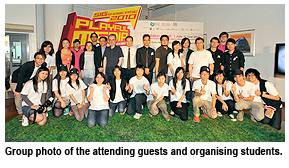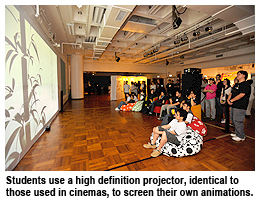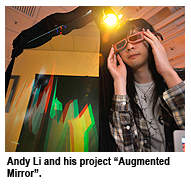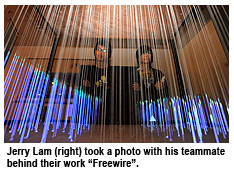Playful Media Exhibition has a “light”-hearted side
The annual Playful Media Exhibition spotlights the artistic and technological qualities of digital media creations produced by School of Creative Media (SCM) students at City University of Hong Kong (CityU).
The exhibition takes place between 1-5 June and is hosted by the Special Interest Group (SIG) in the Bachelor of Science (Hons) in the Creative Media programme. The exhibition displays 33 student projects, including games, animation video and interactive installations, photography and applied artworks. The exhibition demonstrates the students’ creativity and practical skills.
This year the organising students are adding something new to the annual event: the theme “pixel art”. This most primitive form of digital image – pixel graphics like cubes, dots and simple visuals – can be seen in the exhibition’s publicity materials, venue setting and project display design.
In addition to choosing a special theme, the students want to make the show more lively and playful – to match with the characteristics of the Year of the Tiger – by adding more installations and interactive projects.
"Students are more knowledgeable about what to expect and offer in the exhibition because we are now in our 4th year," said Mr Yim Chun-pang, Teaching Fellow in SCM. “Unlike other department’s student exhibitions, which are usually graduation shows, our exhibition is unique in that students from all years will participate. Even postgraduates come back as advisors. This natural mentoring system is exactly how experience accumulates, allowing the exhibition to improve year by year.”
SCM academics are known for their strong industry connections. Thanks to support from sponsors for equipment from the workplace, e.g. slot machines in casinos, high-definition projectors in cinemas, students felt they were doing more than just classroom projects – they were genuinely learning to become professionals and reach industry standards.
The opening ceremony was held on 2 June. The officiating guests were Mr Gabriel Pang Tse-kit, Chairman of Hong Kong Digital Entertainment Association and Dr Hector Rodriguez, Associate Dean of SCM. Professor Way Kuo, President of CityU, also attended the event.
Andy Li Wing-ho, a Year 3 student, set up an interactive installation developed on the "augmented mirror" technique, which uses a one-way mirror to achieve an intuitive augmented reality. His inspiration comes from his interest in philosophical ideas behind the relationship of the mind and body. “I would like visitors to experience for themselves their own mind-body interaction using the brainwave sensor, which shows people’s emotions reflected in the mirror. It’s a way of trying to answer philosophical questions about ourselves,” he said.
Another project "Freewire" was designed by Jerry Lam Chi-hon and two teammates, all Year 3 students. "Freewire" is a combination of installation, interaction, motion detection and projection, giving viewers a new visual experience. The students simulated four scenarios – fireworks, rain, waves and a fountain – using the technique of volume rendering, e.g. creating depth of field using, in this case, several suspended cotton threads. By interacting with these scenarios, the audience gets to experience the fundamental elements that create objects – dots, lines, surfaces and cubes.
"The most difficult part is how to correctly set the threads for the projection. We need very detailed and careful calibration. Setting formulas and computer calculations are relatively easy. But we think the hard work has really paid off," Jerry added. SIGs were initiated by SCM faculty members in 2005. They enable in-depth learning and training for students from Year 1 onwards. Students sign up for the SIGs that they are particularly interested in, and initiate and participate in projects that cover games, animation and special visual effects, installation, web-radio, photography and digital art design.


